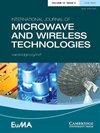Overcoming the relative bandwidth limitations of single VCO frequency synthesizers by implementing a novel PLL architecture
IF 1.3
4区 计算机科学
Q3 ENGINEERING, ELECTRICAL & ELECTRONIC
International Journal of Microwave and Wireless Technologies
Pub Date : 2024-02-23
DOI:10.1017/s1759078723001484
引用次数: 0
Abstract
Frequency-modulated continuous-wave radar systems profit from increasing the absolute bandwidths of the generated frequency chirps to improve range resolution. As the relative bandwidth of SiGe-voltage-controlled oscillators (VCOs) is limited to about 80%, increasing the center frequency fundamentally or via frequency multiplication is the most direct way to increase that absolute bandwidth. However, as some applications require penetration depth, which dramatically decreases with frequency, other solutions are necessary. Therefore, state-of-the-art concepts rely on the down-conversion of generated frequency chirps via two separately stabilized frequency sources. This article implements a novel architecture, offering relative bandwidths of >100% within a single phase-locked loop (PLL). Therefore, two VCOs at different center frequencies are fed into a down-conversion mixer, whose output is directly stabilized via that PLL with one loop filter generating both tuning voltages. Those circuit blocks can be summarized as one equivalent VCO, offering a higher relative bandwidth and a significantly more linear tuning curve. Thereby, a solution to limited relative bandwidths with high VCO gain variation of single VCO synthesizers is offered while substantially reducing the hardware and implementation effort compared to the state-of-the-art.通过实施新型 PLL 架构克服单 VCO 频率合成器的相对带宽限制
频率调制连续波雷达系统可以通过增加所产生频率啁啾的绝对带宽来提高测距分辨率。由于 SiGe 压控振荡器 (VCO) 的相对带宽限制在 80% 左右,因此从根本上或通过频率倍增提高中心频率是增加绝对带宽的最直接方法。然而,由于某些应用需要穿透深度,而穿透深度会随着频率的增加而急剧下降,因此必须采用其他解决方案。因此,最先进的概念依赖于通过两个单独稳定的频率源对产生的频率啁啾进行下变频。本文采用了一种新颖的架构,在单个锁相环 (PLL) 内提供 100%的相对带宽。因此,两个中心频率不同的 VCO 被送入一个下变频混频器,其输出通过该 PLL 直接稳定,一个环路滤波器产生两个调谐电压。这些电路块可概括为一个等效 VCO,提供更高的相对带宽和更线性的调谐曲线。因此,单 VCO 合成器的相对带宽有限、VCO 增益变化大的问题得到了解决,同时与最先进的合成器相比,大大减少了硬件和实施工作。
本文章由计算机程序翻译,如有差异,请以英文原文为准。
求助全文
约1分钟内获得全文
求助全文
来源期刊

International Journal of Microwave and Wireless Technologies
ENGINEERING, ELECTRICAL & ELECTRONIC-TELECOMMUNICATIONS
CiteScore
3.50
自引率
7.10%
发文量
130
审稿时长
6-12 weeks
期刊介绍:
The prime objective of the International Journal of Microwave and Wireless Technologies is to enhance the communication between microwave engineers throughout the world. It is therefore interdisciplinary and application oriented, providing a platform for the microwave industry. Coverage includes: applied electromagnetic field theory (antennas, transmission lines and waveguides), components (passive structures and semiconductor device technologies), analogue and mixed-signal circuits, systems, optical-microwave interactions, electromagnetic compatibility, industrial applications, biological effects and medical applications.
 求助内容:
求助内容: 应助结果提醒方式:
应助结果提醒方式:


